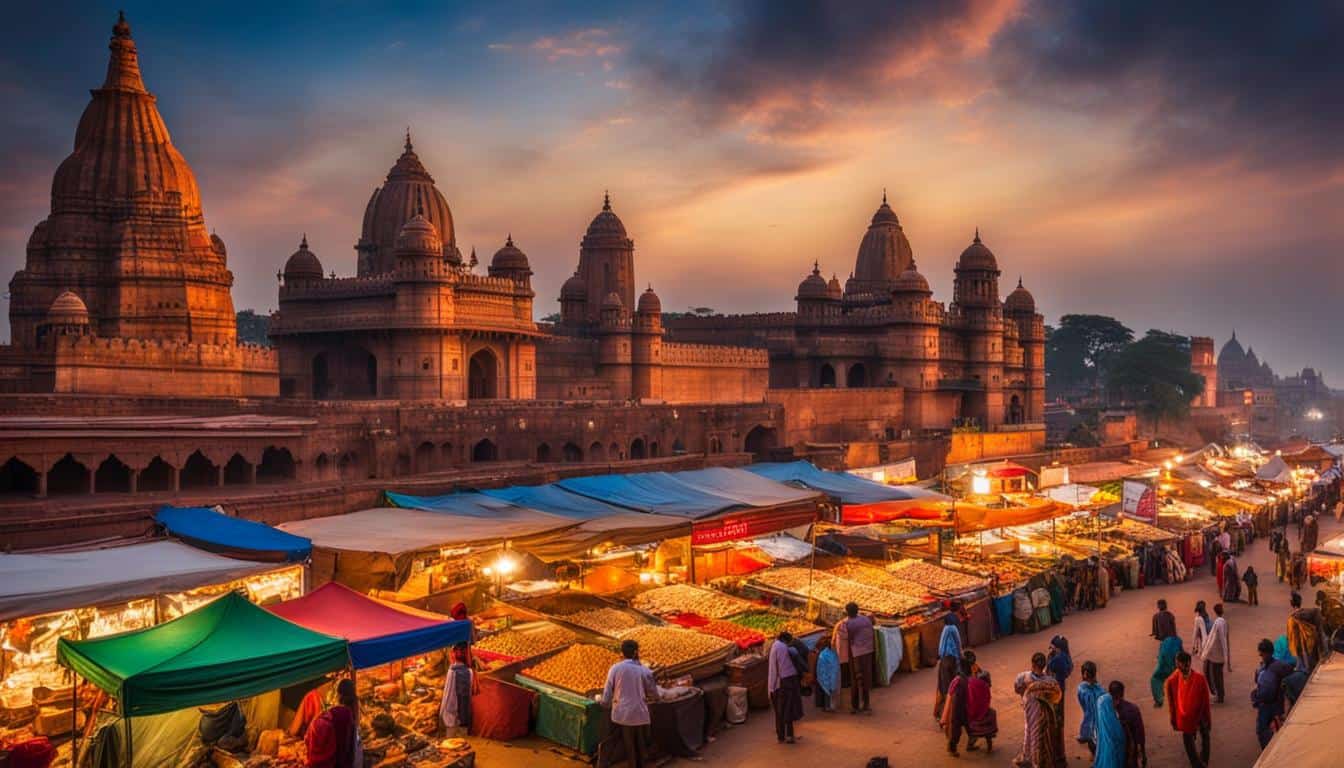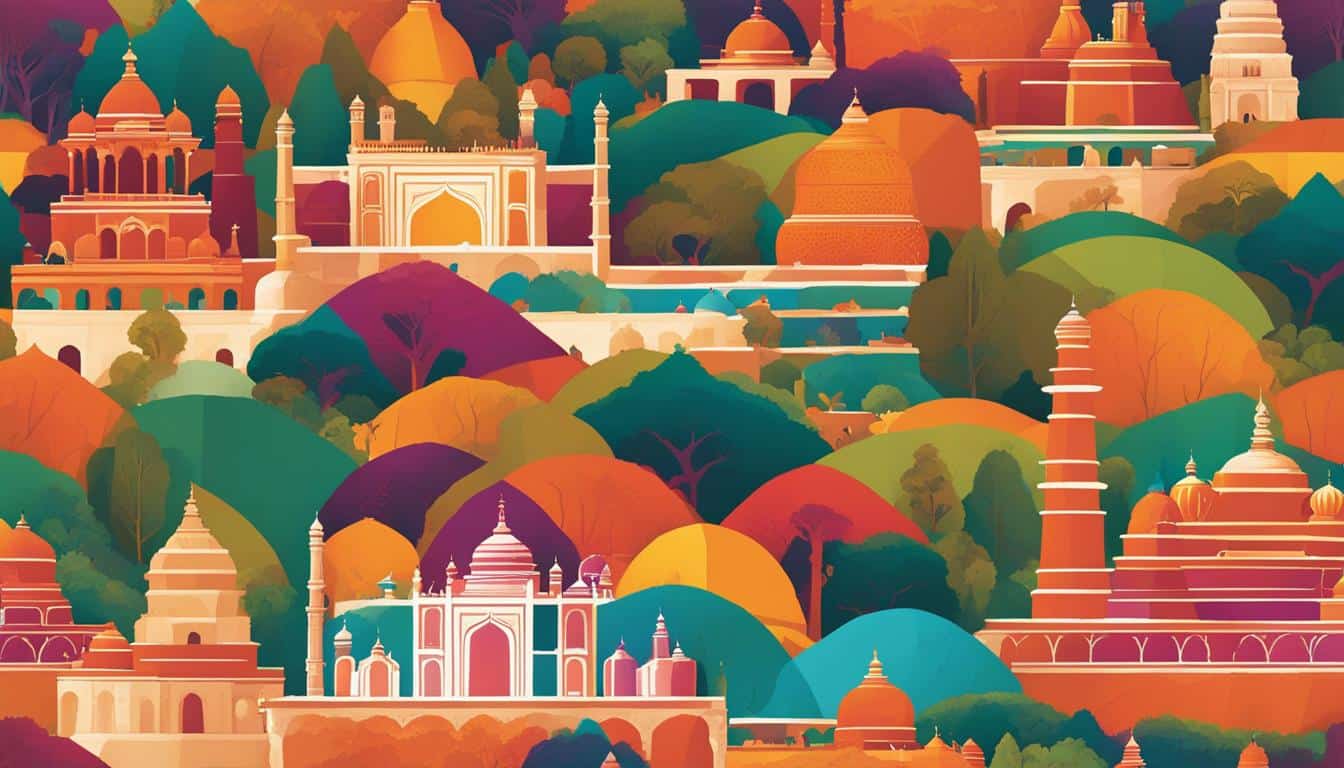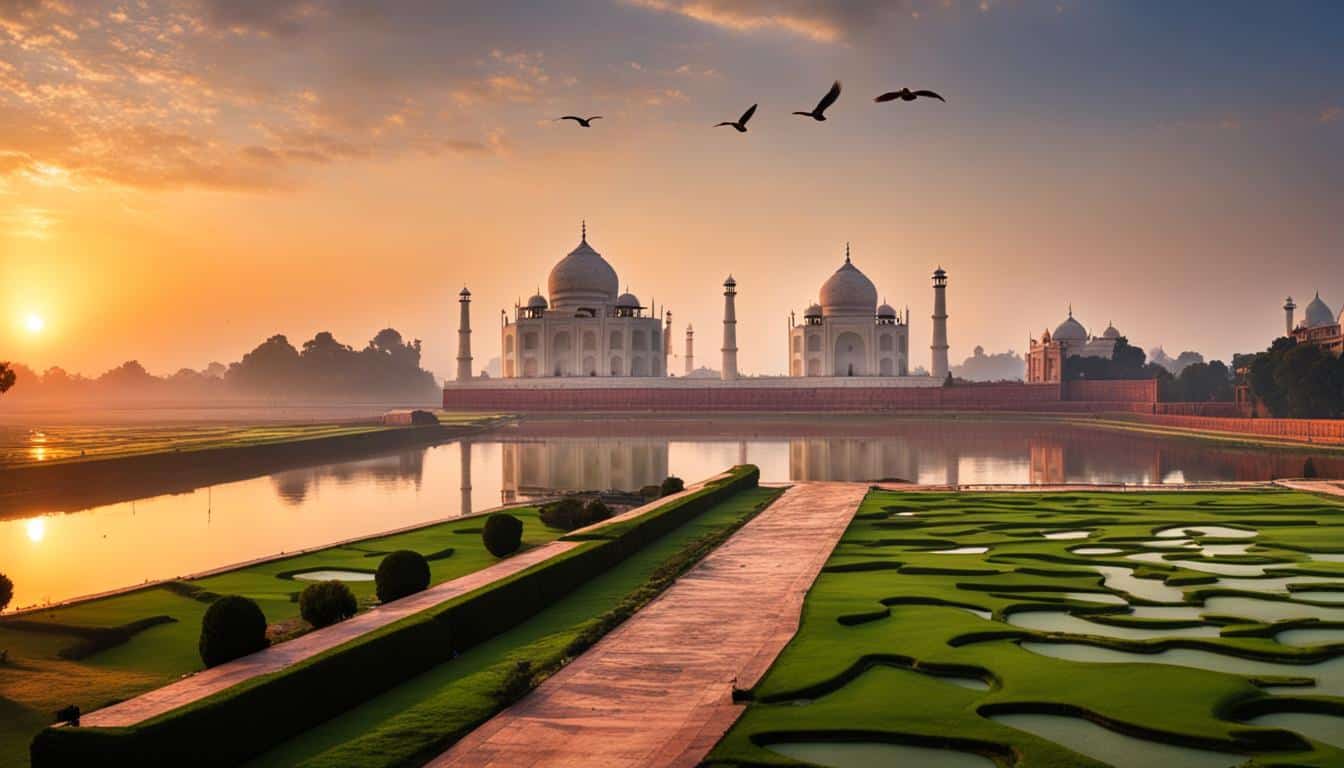Welcome to our comprehensive travel guide to India! If you’re planning a trip to this vibrant and diverse country, you’ve come to the right place. Whether you’re seeking ancient traditions, bustling cities, stunning landscapes, or delicious cuisine, India has something for everyone. In this guide, we’ll provide you with essential tips and information to help you make the most of your journey through this magical country.
Key Takeaways:
- Explore India’s rich cultural heritage and diverse landscapes
- Include must-see attractions like the Taj Mahal and vibrant cities in your itinerary
- Traveling in India requires preparation and awareness of local customs
- Get around using trains, ride-sharing apps, and traditional modes of transport
- Experience the delicious flavors of Indian cuisine, but be cautious with street food
Must-See Attractions for Your India Itinerary
India is home to numerous must-see attractions that should be included in any itinerary. From the iconic Taj Mahal in Agra to the magnificent palaces of Rajasthan, there is no shortage of breathtaking sights to explore. Other popular attractions include the bustling streets of Delhi, the serene backwaters of Kerala, and the spiritual city of Varanasi. Make sure to add these top tourist attractions to your India travel itinerary for an unforgettable experience.
Popular Tourist Attractions in India
| Destination | Description |
|---|---|
| Taj Mahal, Agra | A UNESCO World Heritage Site and one of the Seven Wonders of the World, the Taj Mahal is a masterpiece of Mughal architecture. |
| Jaipur, Rajasthan | Known as the “Pink City,” Jaipur is famous for its stunning palaces, forts, and vibrant markets. |
| Delhi | The capital city of India is a bustling metropolis with a rich history, including iconic landmarks like the Red Fort and Jama Masjid. |
| Varanasi, Uttar Pradesh | A sacred city on the banks of the River Ganges, Varanasi is renowned for its spirituality, ancient temples, and mesmerizing Ganga Aarti ceremony. |
| Kerala | Explore the tranquil backwaters of Kerala, where you can cruise along picturesque canals and witness the beauty of the region’s lush landscapes. |
These are just a few examples of the incredible attractions that India has to offer. Each region has its own unique charms and cultural heritage, so be sure to research and plan your itinerary according to your interests. Whether you’re a history enthusiast, nature lover, or foodie, India’s diverse attractions will leave you in awe.
Essential Tips for Traveling in India
Traveling in India can be an exciting and enriching experience, but it’s important to be prepared. Here are some essential tips to ensure a smooth journey.
Embrace the Culture
India is a country with a rich and diverse culture, so take the time to immerse yourself in it. Slow down and appreciate the traditions, festivals, and local customs. Engage with the locals and learn from their experiences. By embracing the culture, you’ll have a more authentic and fulfilling travel experience.
Stay Safe and Vigilant
While India is generally a safe destination, it’s always wise to take basic precautions. Be cautious of scams, especially in tourist areas, and only trust reliable sources of information. Avoid walking alone at night, especially in unfamiliar areas. Keep your belongings secure and be mindful of your surroundings. It’s also a good idea to register with your embassy or consulate and keep their contact information handy.
Respect Local Customs
India has a rich tapestry of customs and traditions, and it’s important to respect them. Dress modestly, especially when visiting religious sites, and cover your shoulders and knees. Remove your shoes before entering temples and other religious places. When in doubt, observe and follow the locals’ behavior. By showing respect for the local customs, you’ll not only avoid any unintentional offense but also gain a deeper understanding and appreciation of the culture.

Regional Delicacies
India’s regional cuisines offer a diverse array of flavors and cooking styles. Each state has its own specialty dishes that are a testament to the rich cultural heritage of the region. From the spicy curries of Kerala to the hearty thali meals of Gujarat, your taste buds will be taken on a journey of discovery.
| Region | Specialty Dish |
|---|---|
| Punjab | Sarson Ka Saag and Makki Ki Roti |
| West Bengal | Rosogolla and Machher Jhol |
| Tamil Nadu | Idli and Dosa |
| Uttar Pradesh | Galouti Kebab and Lucknowi Biryani |
These are just a few examples of the countless regional delicacies you can savor during your visit to India. Each dish tells a unique story and is a reflection of the local traditions and ingredients. Don’t be afraid to venture off the beaten path and try something new. You might just discover your new favorite Indian dish.
Cultural Etiquette in India
When visiting India, it’s important to respect the local customs and etiquette. Understanding and adhering to the cultural norms will not only show respect, but also enhance your overall experience in this diverse country. Here are some key aspects of Indian culture and etiquette to keep in mind:
Dress Modestly and Respectfully
Modesty in dress is highly valued in Indian culture, especially when visiting religious sites. It is important to dress conservatively and avoid revealing clothing. Women should cover their shoulders, legs, and avoid low-cut tops. Men should also dress modestly, avoiding shorts and sleeveless shirts. By dressing respectfully, you show reverence for the local customs and traditions.
Mind Your Manners
Politeness and respectful behavior are highly appreciated in Indian culture. When interacting with locals or those working in the hospitality sector, it is important to use appropriate language and maintain a calm demeanor. Being patient, understanding, and practicing good manners will go a long way in building positive relationships and creating memorable interactions.
Be Mindful of Gender Relations
Gender relations in India can be different from what you may be accustomed to. It is important to be aware of cultural sensitivities and avoid overfriendliness, especially with people of the opposite sex. Maintain a respectful distance and avoid physical contact unless initiated by the other person. By being mindful of these cultural nuances, you can avoid unintentional offense and foster positive connections.
| Do | Don’t |
|---|---|
|
|
By following these cultural etiquette tips, you can navigate your journey in India with respect and sensitivity. Embracing the local customs and traditions will not only enrich your travel experience, but also contribute to a positive cultural exchange.
Best Time to Visit India
When planning your trip to India, it’s essential to consider the best time to visit based on your preferences and the region you plan to explore. The country experiences diverse weather patterns throughout the year, so understanding the seasons can help you make the most of your journey.
Seasons in India
India has three main seasons: summer, monsoon, and winter. The summer months of May and June can be scorching hot, especially in the northern plains. If you’re not accustomed to high temperatures, you may find it uncomfortable to travel during this time. However, if you’re planning to visit the mountainous regions of northern India, such as Himachal Pradesh or Ladakh, summer can be an ideal time as the weather is pleasant and perfect for outdoor activities.
The monsoon season in India occurs from July to August and brings heavy rainfall across the country. This is a great time to visit if you enjoy the lush green landscapes and want to experience the beauty of the rainy season. However, it’s important to note that some areas, especially those prone to flooding, may not be accessible during this time. Be sure to check the weather forecast and plan your itinerary accordingly.
Winter in India, from December to February, can vary in temperature depending on the region. The northern parts of the country can get quite cold, while the southern and coastal areas enjoy a milder climate. If you’re planning to visit popular tourist destinations like Rajasthan, Delhi, or Agra, winter is a great time as the weather is pleasant and comfortable for sightseeing.
Shoulder Seasons
If you prefer moderate temperatures and want to avoid the peak tourist season, consider visiting during the shoulder seasons. The months of March-April and September-November offer a balance between pleasant weather and fewer crowds. During these times, you can explore popular attractions without the overwhelming tourist rush and also enjoy the local festivals and cultural events that take place throughout the country.
| Season | Best Time to Visit | Advantages |
|---|---|---|
| Summer | April-June | Ideal for mountainous regions, pleasant weather |
| Monsoon | July-August | Lush green landscapes, unique experience |
| Winter | December-February | Pleasant weather for sightseeing |
| Shoulder Seasons | March-April, September-November | Moderate temperatures, fewer crowds |
Remember to research the specific regions and cities you plan to visit as some areas may have different weather patterns and microclimates. It’s also important to check for any local festivals or events that may attract large crowds or affect availability of accommodations.

“The best time to visit India depends on your preferences and the experiences you want to have. Whether you’re seeking adventure in the mountains, exploring ancient temples, or immersing yourself in vibrant festivals, India has something to offer in every season.” – Travel Expert
Money and Practical Tips for Traveling in India
When traveling in India, it’s important to manage your money wisely and be prepared for the unique costs associated with this vibrant country. Here are some practical tips to help you navigate your finances during your trip:
1. Carry small bills for ease of payment
Getting change can be challenging in India, so it’s advisable to carry smaller denominations of currency. This will make it easier to pay for smaller purchases, such as street food or public transportation fares.
2. Plan for ATM withdrawals and foreign transaction fees
ATMs are easily accessible in most cities, but be aware of any foreign transaction fees imposed by your bank. It’s a good idea to inform your bank of your travel plans to avoid any issues with your cards. Additionally, consider withdrawing a larger amount of cash to minimize trips to the ATM and potential fees.
3. Budget-friendly accommodation options
India offers a range of accommodation options to suit every budget. Consider staying in budget hotels, guesthouses, or hostels for cost-effective lodging. These options often provide essential amenities and a chance to connect with fellow travelers.
4. Explore affordable dining options
Indian cuisine is known for its diverse flavors and affordable street food. By eating at local eateries and street stalls, you can experience authentic Indian dishes without breaking the bank. Just be sure to choose busy stalls with high turnover to ensure the freshness of the food.
5. Protect your personal belongings
While India is generally a safe country for tourists, it’s always important to take precautions to prevent theft. Keep your belongings secure and be mindful of pickpockets in crowded areas. Consider using a money belt or a secure bag for your valuables.
By following these money-saving tips, you can make the most of your travel budget while exploring the incredible sights and experiences that India has to offer.
Conclusion
India is truly a remarkable destination that offers a wealth of experiences for travelers. With its diverse culture, stunning landscapes, and captivating history, it’s no wonder that India is considered one of the best travel destinations in the world.
By following this top travel guide India, you will be equipped with the essential tips and information to make the most of your journey. From must-see attractions like the iconic Taj Mahal and bustling Delhi streets, to exploring the rich Indian cuisine and immersing yourself in the local customs and traditions, India has something for everyone.
So, if you’re seeking an unforgettable adventure, look no further than India. With its vibrant cities, ancient architecture, and breathtaking natural wonders, this extraordinary country will leave you in awe. Plan your trip, pack your bags, and get ready to embark on an incredible journey through India.
FAQ
Is India safe for travelers?
India is generally a safe country to visit, but it’s important to take basic precautions and be aware of your surroundings. Avoid traveling alone at night, keep your belongings secure, and follow any local advisories or guidelines.
Do I need a visa to visit India?
Yes, most travelers to India require a visa. You can apply for an e-visa or visit the Indian embassy or consulate in your country to obtain a tourist visa. Make sure to check the specific visa requirements based on your nationality.
What is the best time to visit India?
The best time to visit India depends on the region and your preferences. The winter months from December to February offer pleasant weather in most parts of the country. The shoulder seasons of spring and fall are also ideal for pleasant weather and fewer crowds. Research the specific region you plan to visit for the best time to go.
How do I get around in India?
India has a well-connected transportation system. Trains are a popular option for long-distance travel, while ride-sharing apps like Uber and Ola Cabs are convenient for shorter journeys within cities. Tuk-tuks, or auto-rickshaws, are another mode of transport. It’s important to plan your transportation ahead and be flexible with your itinerary to accommodate any delays or changes.
What should I wear in India?
India is a conservative country, so it’s advisable to dress modestly, especially when visiting religious sites. Women should avoid short skirts or revealing clothing, and both men and women should cover their shoulders and knees. It’s also a good idea to carry a scarf or shawl for additional coverage when needed.
Is street food safe to eat in India?
Street food in India is delicious, but it’s important to exercise caution. Stick to busy stalls with high turnover to ensure the food is fresh. Avoid raw or unpeeled foods and drink filtered or bottled water. It’s also recommended to eat freshly cooked food and choose busy restaurants to reduce the risk of foodborne illnesses.
What is the currency in India?
The currency in India is the Indian Rupee (INR). It’s advisable to carry small bills for ease of payment, as getting change for larger denominations can be challenging. ATMs are easily accessible in most cities, and credit cards are accepted in many establishments, but it’s always a good idea to carry some cash for smaller vendors.
